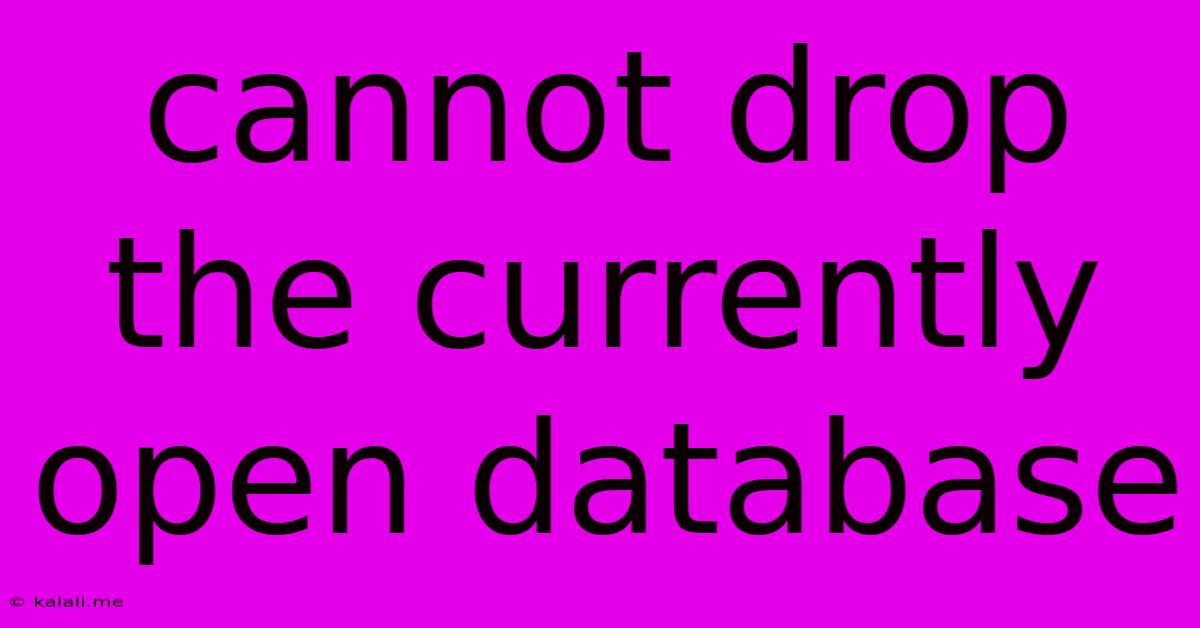Cannot Drop The Currently Open Database
Kalali
Jun 04, 2025 · 3 min read

Table of Contents
Cannot Drop the Currently Open Database: Troubleshooting and Solutions
This frustrating error, "Cannot drop the currently open database," is a common problem encountered by database administrators and developers. It's a straightforward error message, indicating that you can't delete a database while it's actively being used by applications or connections. This article explores the causes and provides practical solutions to resolve this issue. Understanding this problem will save you valuable time and prevent data loss.
Understanding the Problem
Databases, like any resource, need to be closed properly before deletion to avoid data corruption or inconsistencies. The error arises because the database management system (DBMS) needs to ensure all processes and connections using the database are terminated before it can safely remove the database files and associated metadata. Attempting to drop a database while it's open leaves open the possibility of data loss or inconsistencies. The DBMS prevents this by issuing this error.
Common Causes and Troubleshooting Steps
Several scenarios can lead to this error. Let's examine them and their corresponding solutions:
-
Active Connections: The most frequent cause is active connections from applications or users. These could include running applications, background processes, or even connected database clients.
- Solution: Identify and close all active connections to the database. This often involves checking running applications, terminating processes, and disconnecting clients using tools provided by your specific DBMS (e.g., SQL Server Management Studio, pgAdmin). Check for any scheduled jobs or processes that might be accessing the database.
-
Database Mirroring or Replication: If your database is part of a mirroring or replication setup, dropping it directly might be problematic. The DBMS needs to manage the synchronization and consistency across the mirrored or replicated instances.
- Solution: Before dropping the database, you need to properly stop the mirroring or replication process. The exact steps vary depending on the DBMS and the configuration of mirroring/replication. Consult your DBMS documentation for the appropriate procedure.
-
Locked Objects: Sometimes, specific database objects (tables, views, stored procedures) might be locked, preventing the database from being dropped. This usually happens during data modification operations.
- Solution: Identify the locked objects using DBMS-specific commands. For example, in SQL Server,
sp_whoisactivecan help pinpoint blocking sessions. Terminate these sessions after carefully reviewing their purpose. Be extremely cautious when terminating sessions – incorrect termination can lead to data corruption.
- Solution: Identify the locked objects using DBMS-specific commands. For example, in SQL Server,
-
Transaction in Progress: An incomplete transaction can lock resources and prevent the database from being dropped.
- Solution: Rollback any active transactions using the appropriate command (e.g.,
ROLLBACK TRANSACTIONin SQL Server). This ensures data consistency and releases any locks.
- Solution: Rollback any active transactions using the appropriate command (e.g.,
Preventing Future Occurrences
Proactive measures can significantly reduce the likelihood of encountering this error:
- Proper Application Design: Applications should properly manage database connections, ensuring connections are closed when they're no longer needed.
- Regular Database Maintenance: Regularly review active connections and identify any lingering connections that might be consuming resources.
- Understanding DBMS Features: Familiarity with your DBMS's features, particularly concerning connections, transactions, and replication, is crucial.
Choosing the Right Approach
The best solution depends on your specific situation and the DBMS you are using. Always consult the documentation for your specific database system for detailed instructions. Incorrectly terminating connections or forcibly dropping a database can lead to data loss or database corruption. Prioritize methodical troubleshooting and ensure you understand the implications of each step before execution. Remember to back up your data before attempting any major database operations.
Latest Posts
Latest Posts
-
Symptoms Of Bad Hot Water Heater Element
Jun 06, 2025
-
Baking Soda Is Base Or Acid
Jun 06, 2025
-
Albert Einstein Blind Belief In Authority
Jun 06, 2025
-
Jezebel In The Book Of Revelation
Jun 06, 2025
-
Navigate To Another Component On Initialization Using Urladdressable
Jun 06, 2025
Related Post
Thank you for visiting our website which covers about Cannot Drop The Currently Open Database . We hope the information provided has been useful to you. Feel free to contact us if you have any questions or need further assistance. See you next time and don't miss to bookmark.